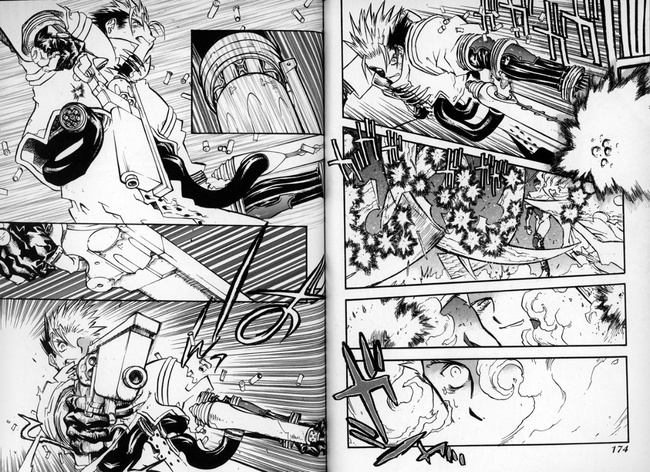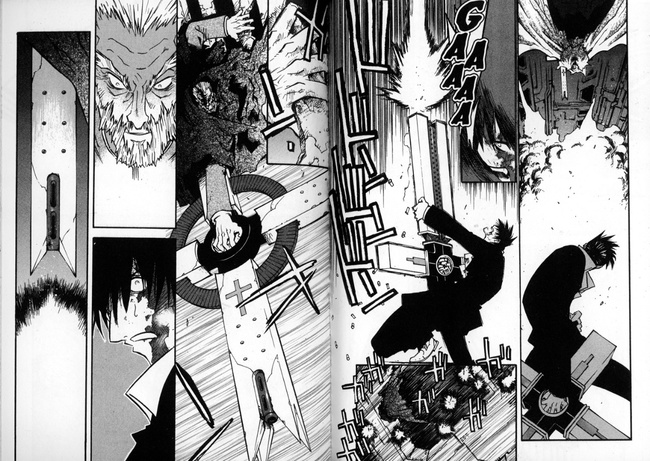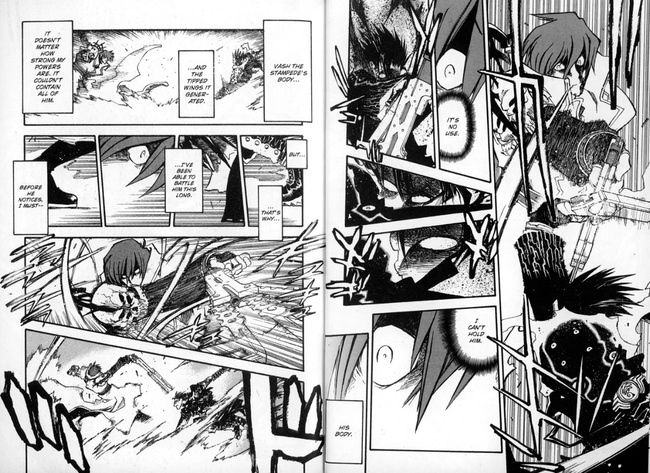Jason Thompson's House of 1000 Manga - Trigun
by Jason Thompson,
Episode CXVII: Trigun
"In English, people use the term ‘dynamic' to politely describe something that is
‘incomprehensible', right? (laughs)"
—Yasuhiro Nightow

Truth in advertising is the text on the cover of Trigun: DEEP SPACE PLANET FUTURE GUN ACTION!! Since it's first appearance in 1996 in Monthly Shônen Captain (from which it shortly moved to the seinen magazine Young King Ours), Yasuhiro Nightow's sci-fi Western Trigun has been a superhit among manga and anime fans, and maybe even some American comic readers, around the world. It's been adapted into two anime, the second one 12 years after the first one, a true test of endurance. I've seen that red longcoat and blonde spiky hair at every anime convention I've been to since 1998. (It does stand out across the room.) All this, even though it's less as half as long as Dragon Ball, Naruto and One Piece. Apparently it's not the length that matters.
The setting: the planet Gunsmoke. The time: the future, when humanity has spread out to the stars. A group of colony ships were forced to crash-land on the nearest planet, a desolate, lifeless heap of sand, inhabited only by the Sandworm-like Sand Dragons. 150 years later, it's not much different, except for a few mining communities, shantytowns, and trains which crisscross the wasteland. Human life on Gunsmoke can only exist thanks to the Plants, super-high-tech energy sources which look like giant, bio-organic light bulbs with a dandelion where the center should be. For over a century, the people of Gunsmoke have waited for ships from Earth to come and rescue them, or at least deliver some water.
Gunsmoke is crawling with outlaws, cyborgs, and steroid-pumping freaks, but one man is the most feared of all: Vash the Stampede, a wandering gunman with a massive price on his head. He's the only man ever declared "a natural disaster," and he's associated with terrible disasters: entire cities blowing up, or the time someone shot a hole in the moon. "He's a time bomb just waiting to go off…" Meryl and Millie, two enthusiastic girls who work for an insurance agency that has to pay for Vash's messes (they're kind of like the opposite of the Dirty Pair), are sent to find the Man in Red to find the truth behind his legendary destructiveness. They're surprised to find that he's actually a sweet, friendly guy. Kind of a goofball, actually; never has any money, scarfs down his food at the boarding house, etc. But when trouble starts (usually bounty hunters attracted by Vash's bounty, in fact) and he's pushed to the edge, Vash reveals his powers: INCREDIBLE AIM. UNBELIEVABLE SPEED. INHUMAN ENDURANCE. Beneath his happy-go-lucky exterior are skillz that could put a bullet between your eyes from halfway around the planet. Except he'd never do that: Vash is a pacifist. When he goes to a firing range, he aims all his bullets at the target's shoulders and hands, rather than the vital areas. He's sworn not to kill, like Rurouni Kenshin, and he must fight the ruthless killers of planet Gunsmoke with his wits, his smile and of course, blunt force trauma!
Trigun and its sequel Trigun Maximum (basically just the continuation of the series under a different name when it switched magazines) is an action manga with great fight scenes, weird bad guys, and detailed science-fiction backgrounds and mecha. The Western theme is more than just Wild West: it's strongly influenced by American action movies and superhero comics, from the chapter titles named after old films (Reservoir Dogs, The Long Goodbye, etc.) to the Todd McFarlane action-figurey look of the characters, with their exaggerated physiques and complicated designs. Unlike some superhero-fan manga artists I could name, Yasuhiro Nightow doesn't just insert some Batman cameos or rip off designs from the Marvel Universe; instead, his work mixes the feel of American comics with the feel of manga in a totally original way. Nightow actually understands superheroes; he goes fanboy crazy over artists like Travis Charest, Mike Mignola and Geof Darrow, and he visits San Diego Comic-Con every year. (From an interview with Michael Gombos: "I make attending SDCC as a fan a priority, which is why I always pay for all of my own expenses.") His omake comic about visiting Comic-Con and fanboying out over Geof Darrow is priceless. Nightow's trying to have the best of both worlds, combining (1) the timing and motion effects of manga with (2) the bold poses, double-page compositions and detailed visuals of good superhero comics. (Or to put it another way, he's trying to avoid the weaknesses of both sides: manga's frequently stiff art and superhero comics' terrible pacing and excessive text.) More often than not, the experiment succeeds. When, occasionally, Nightow doesn't succeed, and emphasizes coolness over form, it can be hard to tell what's going on…but hey! "Dynamic" isn't code for "incomprehensible", really! Dark Horse, the publishers of so many great superhero comics, must be proud to publish one of the few manga artists who really gets superheroes.
Of course, any superhero is only as good as their villain. Here, the villain is Vash's own brother, Knives, the dark side to his light. We soon discover that both Vash and Knives are not human: they are humanoid Plants, born out of one of the mysterious power sources on the floating colony ship that founded Gunsmoke. (Incidentally, I'm still not entirely sure whether the plants are supposed to be, you know, plants, or merely living energy sources, like power plants. Perhaps Nightow was playing on the double meaning in English.) At first, they were both innocent children, but when Knives discovered that human scientists had cruelly vivisected other humanoid Plants just like them, he developed a lifelong loathing for the human race. Knives sabotaged the colony fleet, causing it to crash-land on Gunsmoke, and for 150 years, he and Vash have wandered its desert sands. (Plants don't age like humans.) After a century on Gunsmoke observing what jerks humans can be, Knives' goal is to eliminate the human race and free the Plants from human exploitation. "After living 100 years among them, don't you hate human beings?" he asks his brother. All he has to do is point at the countless scars on Vash's body, scars inflicted by human beings.
Vash and Knives, the two most powerful beings on the planet, argue over whether humanity can be saved. "This is war!" shouts Knives. "Do you still expect mankind to just accept those who wield such power as we do? They'd come as a bloodthirsty mob to bind us and kill us!" Vash answers: "If it comes to that, let's run away as fast as we can. And when things have settled down a bit, we'll quietly approach them again." But Knives is unrepentant. He unlocks his true power as a Plant (in addition to, you know, the super-speed and regeneration and everything), a seemingly nanotechnological ability to produce matter in any form. Vash, too, starts to mutate, sprouting guns and tentacles and feathery angel wings (this scene confirmed the information on Japanese Wikipedia that Nightow is a fan of Katsuhiro Otomo). Shapelessness is the ultimate combat power, like the moment when a tentacle reaches out of Vash's arm to grab a bullet out of midair, saving him. It's true: Vash really is a natural disaster. Like his brother, he's a monster with the power to both create and destroy. Can Vash's desire for peace overcome his brother's thirst for destruction?
This is the other way that Trigun is like American superhero comics: the moral conflict between a hero who won't kill and villains who will. It's one of the key elements of Batman (to the point of ridiculousness IMHO), but it's not as common in manga: in manga, you get more of the Fist of the North Star the-hero-kills-villains theme and the One Piece the-heroes-beat-the-crap-out-of-villains-but-nobody-really-dies-in-this-universe-anyway theme. Of course, superheroes aren't all nice guys either; for every Batman, there's a Punisher. In Trigun, the antihero role is filled by Wolfwood, Vash's partner, a priest who carries a giant cross which is actually a concealed machine gun. (Kinda like the title character of Django, who walks around carrying a coffin with a machine gun in it; Nightow even one-upped this design with his coffin-toting hero in the video game Gungrave.) Wolfwood had a horrific past and has suffered nearly as much as Vash, and while he's got a strong sense of justice, he'll kill any evildoer who deserves it. He scoffs at Vash's pacifism: "You're overly optimistic about the world…While you sit around, twiddling your thumbs, everything goes to hell! You think a guy who can't kill a man can save a man?" Vash is already full of guilt for all the people he couldn't save, and he sits in church sometimes, brooding"My sins aren't forgivable." Wolfwood almost agrees. At one point, when Vash has his back to him, Wolfwood points his gun at him and thinks "It would be so easy to pull the trigger…and eliminate half of the threat to the human race…" It's dark and heavy and grim.
But luckily, it never gets too dark. There's always comedy, like the omake images on the inside front and back covers, and the scene when, after a long dramatic battle, Vash and Wolfwood put on construction workers' clothes and get to work repairing the city they just trashed. It's always basically about the thrill of good vs. evil, even when they're fighting the vilest villains, like Legato Bluesummers, a manipulator who spends most of the manga locked in a coffin, using his web of invisible puppeteering wires to do things like forcing forty soldiers to squeeze themselves into a tiny box ("Even as they feel their bodies mashed into hamburger, they can't stop!") Legato is the leader of the Gung Ho Guns, superpowered maniacs who work for Knives, even though they, too, know they'll be killed along with the rest of the human race when Knives achieves his goal. There's Midvalley the Hornfreak, a killer saxophonist who murders people by manipulating sound, leading to an awesome John Woo standoff with a gun pointed at Midvalley's head and a…saxophone…pointed at Wolfwood's. There's Rai-Dei the Blade, a samurai who rides around on rocket rollerblades, and might be inspired by the Samurai Shodown manga adaptation which was Nightow's first published manga, or maybe by Ninja Scroll, one of Nightow's favorite anime. Hoppered the Gunfreak is a human bullet, a legless amputee who stuffed his muscular body into a rocket shell that makes Captain America's shield look like a bottle cap. Gray the Ninelives is an invulnerable brute in black leather who soaks up bullets like they're raindrops. Yasuhiro Nightow designs his characters starting with their silhouettes (incidentally, so does Hiroyuki Takei, although their art styles are extremely different), so they all have a distinct look. Trigun is full of cool characters, and the manga is about seeing them fight. That it's also a good story with a solid ending is a bonus.
When I reread Trigun to write this article I was surprised by how, in places, Nightow's dramatic-poses art style reminded me of Kohta Hirano's (though Hirano's themes of bloody revenge are pretty much the exact opposite of Trigun). Apparently the two artists are friends. Trigun is a good manga, but I think Nightow's greatest strengths are in character design, which is probably why he's done so much character design and animation work, for projects ranging from Gungrave to Oh! Edo Rocket to Balance Sentai Veggie Rangers. Since he finished Trigun in 2008, his only manga work has been a few short stories, such as Blood Blockade Battlefront in Jump Square (also translated by Dark Horse).
I hope Nightow keeps doing manga, and doesn't move entirely into design and illustration. Strangely, even though the main Trigun story is over, even if Nightow doesn't draw it, there's a possibility it might continue. Since the manga ended, the manga artists Boichi and Yu Takeyama have done two Nightow-approved one-shots starring Trigun characters in Shonen Gahosha magazines. Allowing other artists to draw canon, in-universe stories featuring your own characters: what could be more like superhero comics? Neither has been officially translated yet, but I'd love to see more stories set in the Nightowverse.
discuss this in the forum (27 posts) |


